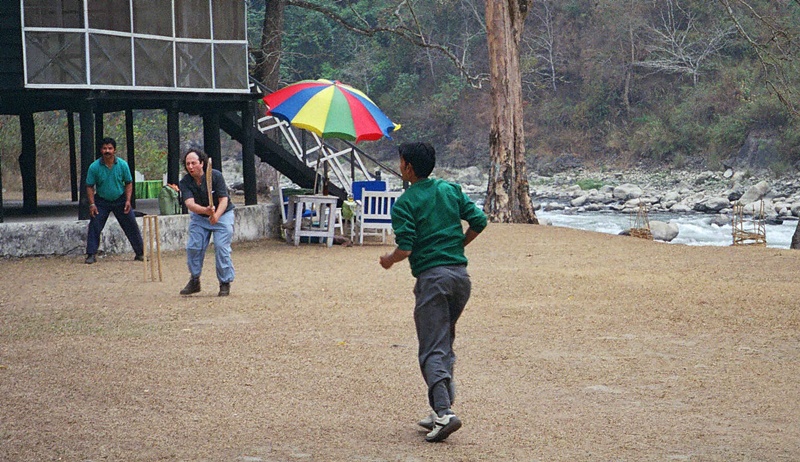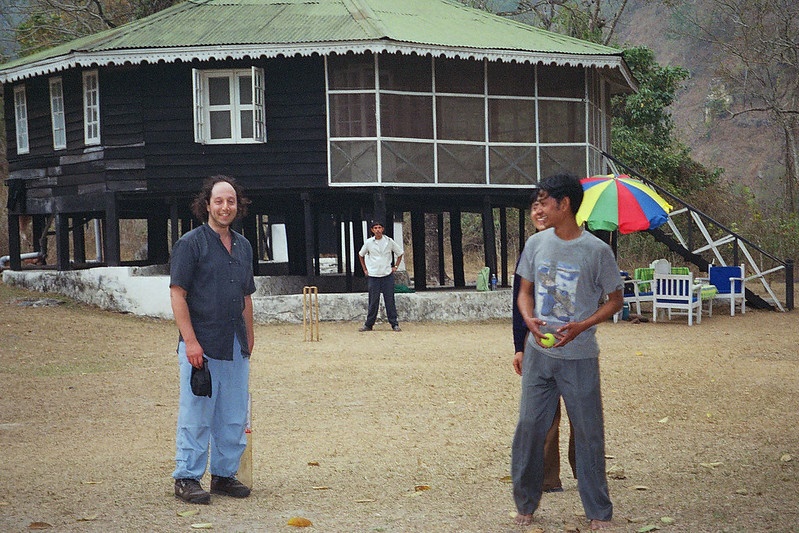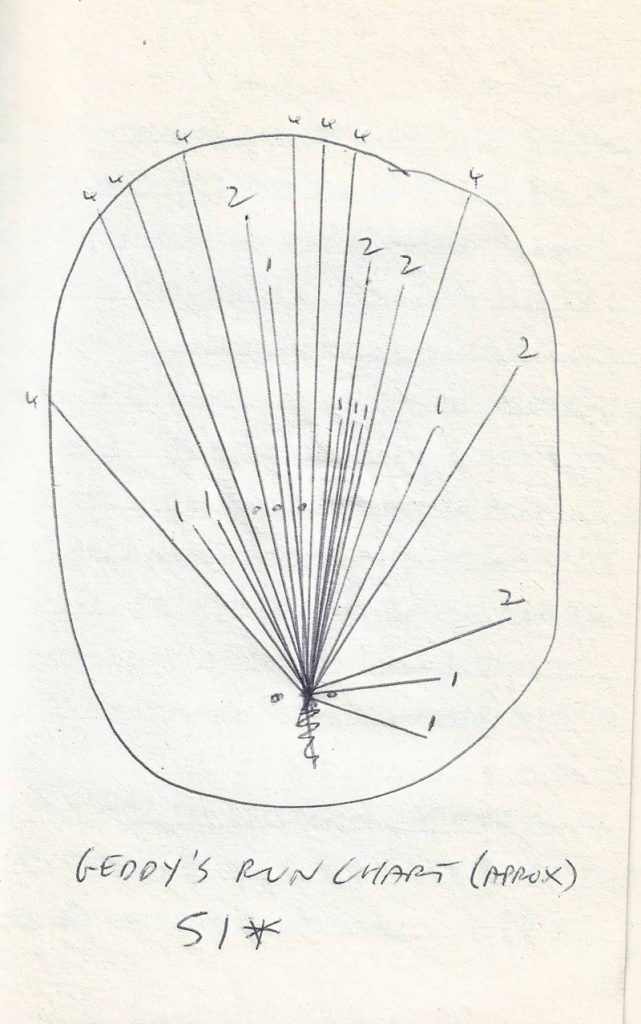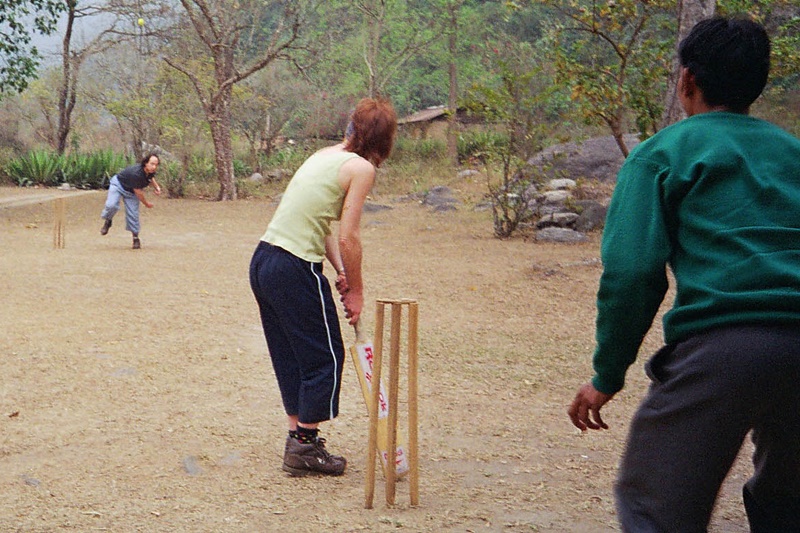Send your match reports to king@kingcricket.co.uk. We’re only interested in what it was like to be at the game, so if it’s a professional match, on no account mention the cricket itself. Equally, if it’s an amateur match, please go into excruciating detail.
Herbert Ackgrass (the official cricket biographer of King Cricket reader and regular contributor, Ged Ladd) writes…
Ged’s highest ever score, 51 not out, was achieved in India during the annus mirabilis that was 2005.
The bad news, for connoisseurs of top-level cricket, is that this was an informal game of cricket on the side of a river in the Darjeeling Hills. The good news, for connoisseurs of King Cricket match reports, is that the amateur nature of the encounter allows – indeed encourages – the biographer to go into excruciating detail in this match report.
The match was a matter of happenstance. Ged and Daisy were touring North-East India, at that juncture staying on a tea estate, Glenburn, near Darjeeling.
On learning that Ged and Daisy are keen on cricket, the hosts suggested a day of walking, picnicking and then some afternoon cricket at the estate’s riverside campsite with those of the estate workers who like to play.
The contemporary (2005) journal includes the picnic aspect of the story; a vital component in any cricket day for Ged:
Jeet directed operations for a fine picnic lunch of barbequed chicken tikka, pickled cucumber salad, chicken mayonnaise with apple, meatloaf, tomato salad and leaf salad (including rocket). We couldn’t even touch the potatoes & rice and barely touched the bananas in caramel sauce. Washed down with a very agreeable beer.
The record of this momentous cricket match includes some rare photographs; the only known photograph of Ged bowling to Daisy and one picture of Ged playing an extremely rare offside shot, albeit rather awkwardly.

The contemporary journal picks up the great man’s match highlights:
After taking out Daisy caught & bowled in warm up, Ged then made 25 before retiring [not out]…- others batted – Muken batted very well before falling stumped by Ged (yes really) off Sujit’s bowling for 44…Ged then had two or three stumpings off his own bowling & resumed his innings to complete 51 not out before retiring again (& closing the game).
There is photographic evidence of handshakes all round and a spirit of bonhomie amongst the former combatants. Just as it should be.

One other extraordinary rarity survives from this historic match; a wagon wheel of Ged’s personal-record-breaking innings, drawn by the man himself, probably that very evening.

Much of the scoring in “the V” and an agreeable mix of on-side and off-side scoring. Mirabilis indeed.




Well this is a rare treat. Top work, Herbert. And the photos give an incredible window into the details of technique that all lovers of the game should admire.
The first photo shows the bowlers balls. Not literally, of course, although I haven’t checked in detail, but metaphorical balls. Beautifully flighted, well above the eye-line, something to tempt the batswoman into something rash. But surely it’s the wrong ‘un. The “obvious” off-break will hold its line in the air, dip a little, present the batswoman with a leg-side opportunity, then nip away, possibly taking the edge, possibly the off-stump, but in any case offering a chance to the keeper. Or it might hit a rock.
And just look at the masterclass in weight transference in the second photo. Marcus Trescothick used to say that foot movement was less important than the way the batsman’s weight was shifted during the shot, and I think we see that same philosophy in action here. Awkward, you write, but what happens when the ball has gone is irrelevant. It was during the shot that the balance was optimised, the feet deliberately held back to open up the space for the bat, weight through the ball. That this leads to a slight stumble in the follow through is hardly of any import, what with the ball racing away into the covers.
All in all, a perfect display. And to cap it all, surely evidence on the wagon wheel of some of the longest shots ever played in cricket. Those leg side boundaries won’t have stopped till they reached the Bay of Bengal.
Great match report Herbert.
It seems that Ged is very strong on the drive.
Is this because of limitations of the pitch square of the wicket? Or is it because the only shot you can physically play is the drive?
I’m desperate to know how many balls ended up in the water!
The only amendment I would make, is that Daisy’s stance could do with a small amount of assistance.
Oh Gawd.
I thought Herbert Ackgrass retired decades ago. I had no idea that he would see through his “threat” to write my cricketing biography. Ackgrass can be a relentless critic – by his standards he’s gone light on me with this performance. I just hope he doesn’t decide to make a habit of reporting my efforts from decades gone by.
Yes, the surface was indeed stoney, Bert, well spotted. So the only type of delivery that stood a chance of taking a wicket was full.
Hence the shots in the V – you could pretty much plant your front foot for the full delivery and sway out of the way if the ball was short. Just occasionally you’d get a ball of good length that would jump up at you, requiring the awkward block to off.
Hitting the ball into the river was one of the modes of dismissal, hence I completely eliminated my usual shot, the hoick to midwicket or backward square leg. It was sound technique to simply leave anything that was delivered leg-side unless it was full and straight, allowing the on-drive. Everyone batted that way, so no balls landed in the river that day.
The river sort-of bent around and there was some scrub which counted as four – that was the one “45-degree-ish on-side shot” which was safe. I also recall benefiting from one fielder who was extremely short and not very able, who was guarding the off side scrub (also four) – you could safely go aerial route to him because it was easy to get over his head and even if you failed to do that he couldn’t catch to save his life.
Wonderful tea, the Glenburn tea, it really is.
Engaging report. I’d have to confess I am a little suspicious of your hosts’ intentions, Ged. On learning that you and Daisy are keen on playing cricket, first they suggested a day of walking and picnicking and then proceeded to feed you chicken tikka, cucumber salad, chicken mayonnaise with apple, meatloaf, potatoes & rice, bananas in caramel sauce all washed down with beer.
Maybe, just maybe, they didn’t want you to play? And who’d blame them, for all the reasons Bert so eloquently outlines?
Oh, and also, your annus mirabilis was exactly 100 years after Einstein’s. Well done.
Indeed.
But whereas I made several momentous advances in the laws of physics during my annus mirabilis (see the first two photographs in this piece to see a demonstration of mass-energy equivalence through bowling and batting respectively)…
…I don’t believe that Einstein ever scored 51* on an exceptionally spicy, bouncy track.
On the contrary, he has scored 92 against Kerala in addition to bowling off-spin:
https://en.m.wikipedia.org/wiki/Napoleon_Einstein
Thanks Deep Cower. That is a simply wonderful Wikipedia entry. He was 17 years old when he scored 92 in his first List A knock for Tamil Nadu and yet only got one more go. Seems a bit harsh to me.
I love his own explanation for the name – well worth clicking through that Wikipedia link just for that.
Napoleon Einstein – cricket legend. Thanks again, DC.